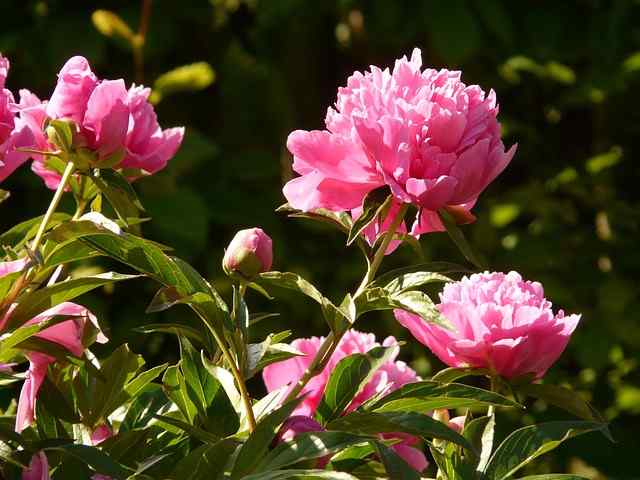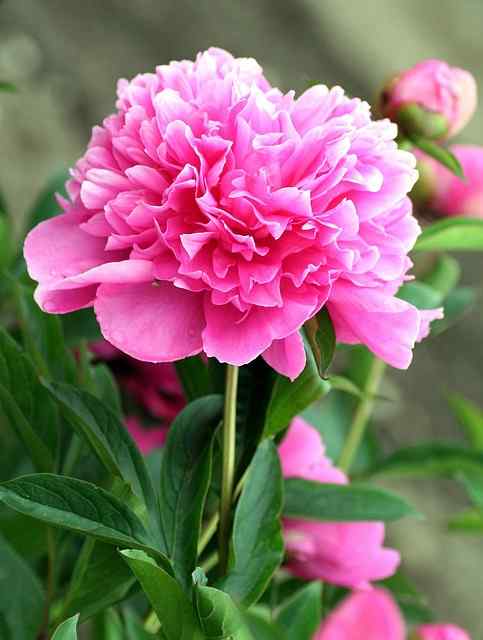In this guide, we’ll cover everything you need to know about the blooming period of peonies, their care, the symbolism they carry, as well as tips for successfully growing these beauties in your own garden.
Understanding Peony Bloom Time

Peonies typically bloom in late spring to early summer, with the exact timing largely dependent on the specific variety of the flower, climate zones, and local weather conditions. Generally, peonies in various regions can begin blooming anywhere from late April to early June. The traditional herbaceous peonies tend to bloom sooner, often starting their show in late April or May. In contrast, tree peonies and Itoh peonies can bloom a little later.
Specific Bloom Times by Variety
Herbaceous Peonies:
These are the most common type of peonies grown in gardens. They emerge from the ground each spring, and their blooms typically occur from late April through June. Varieties such as ‘Sarah Bernhardt’ are known for their soft pink blooms and usually thrive in a range of climates, starting their bloom period in late May.
Tree Peonies:
Tree peonies, which are actually woody plants, bloom slightly later than their herbaceous counterparts, often showcasing their stunning flowers from late May to early June. They produce large, cup-shaped flowers that can be quite striking, making them a sought-after choice for gardeners seeking statement blooms.
Itoh (Intersectional) Peonies:
A hybrid of tree and herbaceous peonies, Itoh peonies typically bloom from mid-May to early June. They offer the best traits of both parents: the robust structure of tree peonies and the lush, full flowers of herbaceous varieties. This makes them a popular choice among gardeners looking for unique blooms.
Factors Influencing Bloom Time
While each type of peony has a general bloom time, several factors can affect when peonies will actually flower in a given year:
Climate and Hardiness Zones:
Peonies are adaptable but thrive in zones 3 to 8. Those in cooler climates may see their peonies blooming later than those in warmer areas. If you’re in a region where frosts are common even in late spring, your peonies might delay flowering until temperatures stabilize.
Weather Conditions:
Sudden changes in temperature can impact bloom times significantly. A warm spell in early spring can prompt peonies to bloom earlier than usual, but if a late frost hits, it can kill the buds. Conversely, long stretches of cool, cloudy weather might delay blooming.
Soil Conditions and Nutrition:
Healthy, well-draining soil enriched with organic material can prevent stress on the plants and allow them to bloom at their optimal time. Inadequate nutrients may cause delayed flowering or reduced flower size.
Watering and Care:
Proper watering practices in the lead-up to blooming are crucial. Deep watering during dry spells encourages robust blooms. Conversely, over-saturation can cause root rot and other issues, stymying growth altogether.
The Beauty of Peony Blooms

When we talk about peonies, we must also acknowledge the sheer beauty they bring to gardens and floral arrangements. With their large, fluffy blooms ranging from delicate pastels to vibrant reds, peonies are a favorite for both casual gardeners and professional florists.
Colors and Varieties
Peonies are notoriously versatile, coming in various forms and colors. They can be found in shades of pink, white, red, yellow, and even a few rare blue varieties. Gardeners can choose from several distinct forms of flowers, including:
Single Flower:
Characterized by a single row of petals surrounding a center of yellow stamens. This form has a more open appearance, which allows for pollinators to easily access the nectar.
Semi-double:
Featuring additional layers of petals, these flowers display a more lush appearance compared to single varieties, yet still maintain a certain airiness.
Double:
With a full, round shape, double peonies are packed with petals and can be incredibly lush, perfect for creating a dramatic impact in gardens or arrangements.
Bomb:
These are extremely full, often globular blooms that resemble fluffy puffs of cotton candy.
Fragrance and Aesthetic Appeal
Beyond their visual allure, peonies are known for their delightful fragrance. Their scent can be intoxicating, ranging from sweetly floral to slightly spicy. Many classic romantic bouquets feature peonies due to their lush texture and captivating aroma.
The aesthetic impact of peonies cannot be overstated. In gardens, they can serve as focal points or complementary plants, making them ideal for mixed borders, cutting gardens, or large mass plantings. When paired with other flowering plants, like lavender or delphinium, peonies bring depth and dimension to an arrangement.
Peony Symbolism and Meaning

Throughout history, peonies have held deep symbolism across cultures. In China, the peony is often referred to as the “king of flowers,” symbolizing wealth, good fortune, and elegance. In the language of flowers, gifting peonies can convey romantic feelings, making them a popular choice for weddings and anniversaries.
Historical Significance
Peonies have been cultivated for over a thousand years, particularly in Asia. They were often used in traditional medicine, valued for their supposed healing properties. Over time, they became a symbol of nobility and prosperity. In Western culture, peonies were embraced as a representation of love and beauty, often included in literature and art to signify rich emotions and springtime.
Cultural Associations
Chinese Culture:
In Chinese art, peonies frequently appear as motifs to symbolize feminine beauty and the concept of love. The peony flower portrays honor and riches, making it popular in artwork, textiles, and ceramics.
Western Traditions:
In the United States and Europe, peonies are often associated with romantic love. Their presence in May weddings is customary, reflective of their lush blooms that signify a hopeful future together.
Ideal Conditions for Peonies to Flourish

To unlock the full potential of peonies and ensure they bloom at their finest, proper cultivation techniques are essential. From soil preparation to care during or after blooming, consider the following tips and insights.
Site Selection
Choosing the right location in your garden is vital for peonies. They thrive in well-drained soils and prefer full sun to partial shade. Ideally, select a site that receives at least six hours of sunlight daily. If you plant them in an area with too much shade, the blooms may not reach their full potential, leading to sparsely blooming plants.
Soil Preparation
Peonies flourish in rich, loamy soil that retains moisture but drains adequately. Before planting, amend the soil with compost or well-rotted manure to enhance nutrient levels. Conducting a soil test can help ascertain pH levels, allowing you to make necessary adjustments for optimal peony health. Aim for a slightly acidic to neutral pH (6.0 to 7.0).
Planting Time
The best time to plant peonies is in fall or early spring. Planting in the fall gives the roots time to establish themselves before winter dormancy, resulting in healthier blooms the following season. If planting in spring, ensure a minimum of four to six weeks before the last frost to give the plants time to acclimatize.
Watering Techniques
Peonies thrive on consistent moisture, particularly during their blooming period. During dry spells, especially while buds are forming, deep watering is essential. Apply mulch around the plants to help retain soil moisture while also controlling weed growth.
Pruning After Bloom
Once blooming has finished, it’s essential to care for your peony plants properly. Prune away spent flowers to encourage future growth and prevent disease spread. Additionally, if the foliage begins to yellow in late summer, remove it to keep the plant healthy. However, it’s best to leave the foliage intact until fall since leaves contribute to photosynthesis and help the plant store energy for the next blooming season.
Fertilization
Although peonies can grow reasonably well in nutrient-rich soils, additional fertilization may enhance their blooming potential. Using a balanced, slow-release fertilizer in early spring supports the development of lush foliage and abundant flowers. Avoid high-nitrogen fertilizers; too much nitrogen can lead to decreased flowering and excessive leafy growth.
Extending the Peony Blooming Season

While peonies have a relatively short bloom window, around 7 to 10 days for most varieties, there are several strategies to extend the enjoyment of peony blooms in your garden.
Companion Planting
By interplanting peonies with other flowers that have varying bloom times (like daylilies or summer perennials), you’ll create a continuous display in your garden even after the peonies have finished blooming. This approach builds a more layered and textured look and ensures your garden remains vibrant throughout the growing season.
Transition Flowers
As your peony blooms fade, consider incorporating transitional flowers, such as foxgloves, daisies, or asters, which bloom just as the peonies finish, maintaining the visual interest in your garden.
Cut Flower Practices
If you intend to cut peonies for arrangements, trending toward early-morning harvesting is optimal, when they are still fresh. Cut stems at an angle with adequate stems for effective water uptake. Remove excess foliage and allow the cut flowers to benefit from cool, shaded environments. This practice not only provides beautiful arrangements but can also encourage further blooming from the remaining plants.
Conclusion: Cherishing the Peony Bloom Time
Understanding the bloom time of peonies gives gardeners a unique appreciation for these wonderful flowers. From their rich cultural significance to the sheer joy they bring in gardens and homes, peonies are more than just seasonal blooms—they are symbols of beauty, love, and new beginnings.





